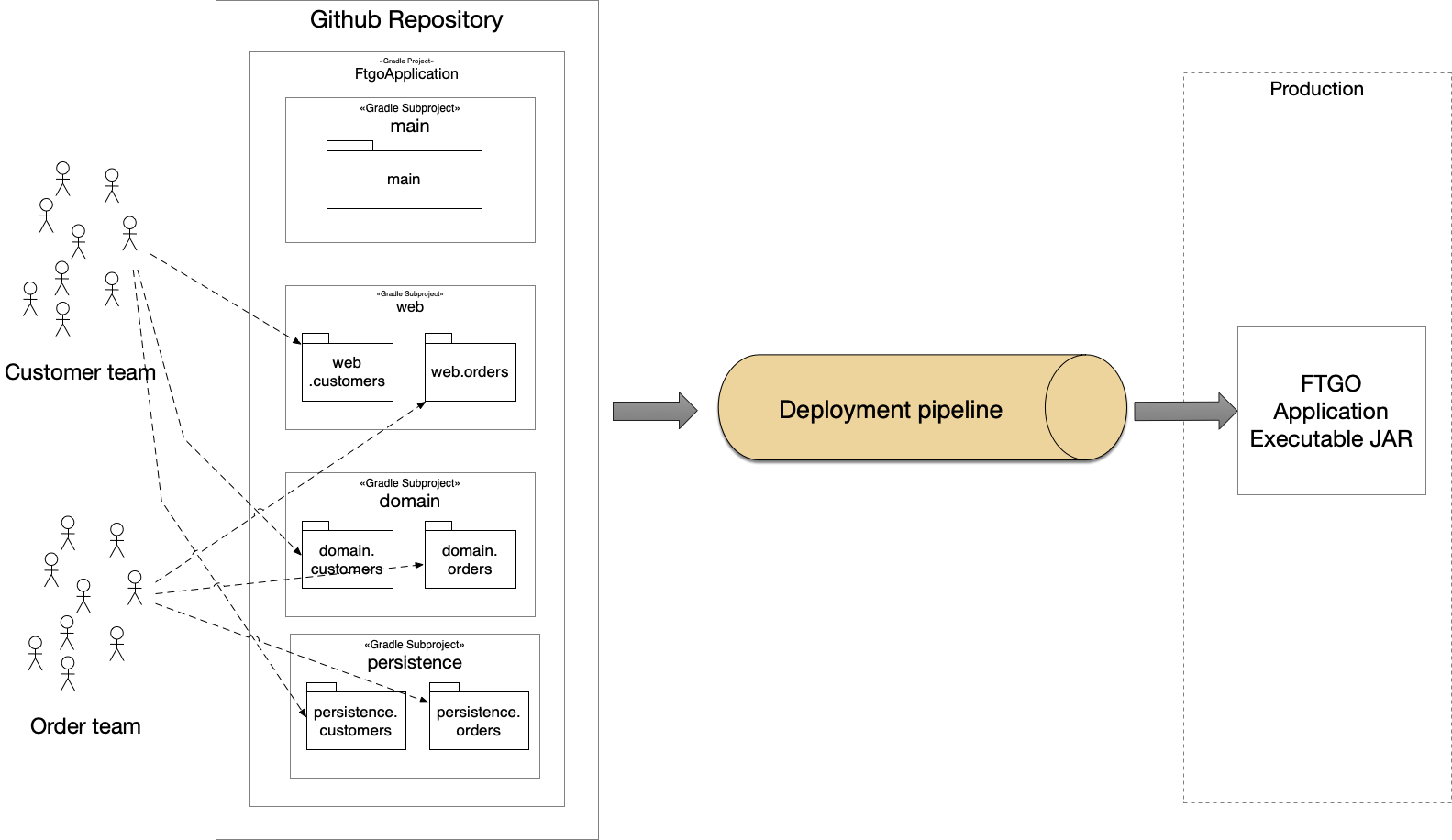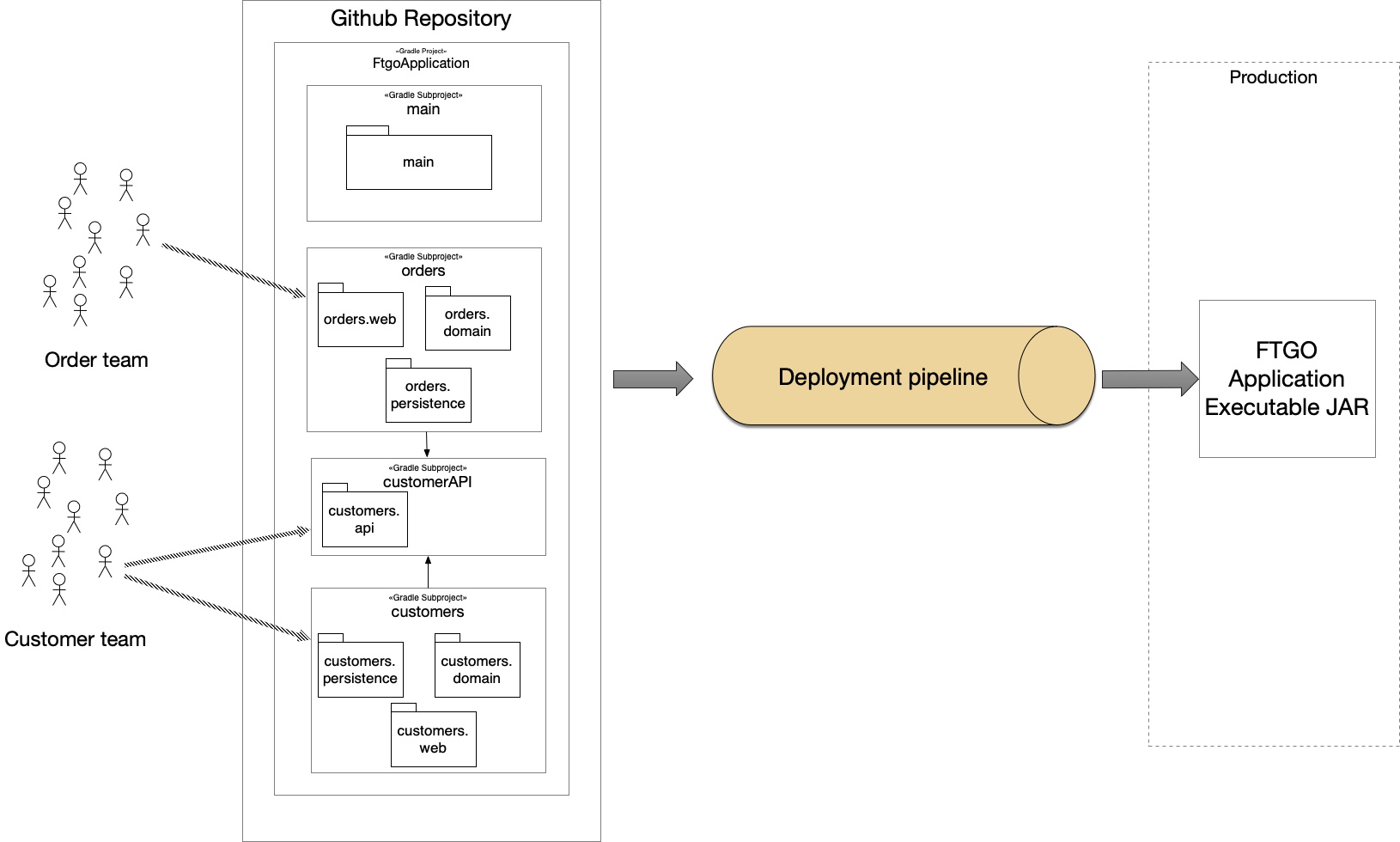How modular can your monolith go? Part 7 - no such thing as a modular monolith?
architecting modular monolithContact me for information about consulting and training at your company.
The MEAP for Microservices Patterns 2nd edition is now available
This article is the seventh in a series of articles about modular monoliths. The other articles are:
- Part 1 - the basics
- Part 2 - a first look at how subdomains collaborate
- Part 3 - encapsulating a subdomain behind a facade
- Part 4 - physical design principles for faster builds
- Part 5 - decoupling domains with the Observer pattern
- Part 6 - transaction management for commands
Quite some time ago, I wrote about how there’s no such thing as a microservice. I explained how the term ‘microservices’ is a shorthand for ‘microservice architecture’, which is an architectural style that structures the application as a loosely coupled set consisting of two or more components (a.k.a. services). As a result, a service cannot exist in isolation; it must be part of a larger whole. In this article, I explain why there’s no such thing as a modular monolith and why the term ‘domain-oriented component architecture’ might be a better choice.
What’s the monolithic architecture?
The monolithic architecture is an architectural style that structures the application as a single component, such as a single WAR file or executable JAR.

The component implements all of the application’s subdomains/bounded contexts.
The component’s internal architecture is a black box
From the perspective of the application (or system) architecture, each of its constituent components is a black box. A component’s details are hidden behind its API. Given, therefore, that the term ‘monolith’ is shorthand for ‘monolithic architecture’, it follows that there’s no such thing as a modular monolith(ic architecture).
Modular monolith => modular components
When we use the term ‘modular monolith’, what we are really describing is the internal architecture of a component. The sole component of a monolithic architecture is likely to be large so modularity is especially important. However, there’s no reason why the services within a microservice architecture should not also be modular. In particular, some services might consist of multiple subdomains/bounded contexts owned by different teams. The problems that the ‘modular monolith’ pattern solves are not necessarily unique to the monolithic architecture. Consequently, perhaps a better term is ‘modular component’.
Modular components => domain-oriented components
Now that we have looked at why, perhaps, ‘modular component’ is a more accurate that ‘module monolith’, let’s now look at why the adjective ‘modular’ is not the best choice for the architectural style that we are trying to describe.
A traditional monolith can have a well-defined structure
Monolithic applications are often described as big balls of mud. To quote Foote and Yoder, the authors of that pattern, such a monolith is a “haphazardly structured, sprawling, sloppy, duct-tape and bailing wire, spaghetti code jungle.” However, there’s no reason for a monolithic application to be a big ball of mud. It could have a well-defined structure consisting of layers, which themselves are comprised of modules.
For example, here’s the FTGO monolith:

This monolith is comprised of four layers: main, web, domain and persistence.
The web, domain and persistence layers consist of domain-specific modules.
The lack of modularity is not the problem.
Real problem: The layers and modules are not aligned with the subdomains/bounded contexts
One actual problem is that the layers and modules are not aligned with application’s subdomains/bounded contexts.
For example, it’s common for the layers to be technical: web, domain and persistence.
As a result, a subdomain/bounded context will typically span multiple layers and modules.
Real problem: The layers and modules are not aligned with the teams
Another actual problem is that the layers and modules are not aligned with the teams that own the subdomains/bounded contexts. As a result, teams need to make changes across multiple layers and modules to implement a feature. It’s an architecture that reflects a traditional siloed organization rather than a modern organization one that’s structured using Team Topologies.
Big idea: organize a component around the domains
The big idea with the modular monolith (component) pattern is that its top-level organizing principle are the domains/bounded contexts. For example:

In this architecture, the monolith consists of modules, such as customers and orders.
Each module, in turn, consists of layers, such as web, domain and persistence.
As a result, the application architecture and the teams are aligned.
Better name: domain-oriented component architecture?
Arguably, the term domain-oriented component or even domain-oriented component architecture is more accurate than modular monolith (component).
What do you think?
Need help with modernizing your architecture?
I help organizations modernize safely and avoid creating a modern legacy system — a new architecture with the same old problems. If you’re planning or struggling with a modernization effort, I can help.
Learn more about my modernization and architecture advisory work →


 Premium content now available for paid subscribers at
Premium content now available for paid subscribers at 




